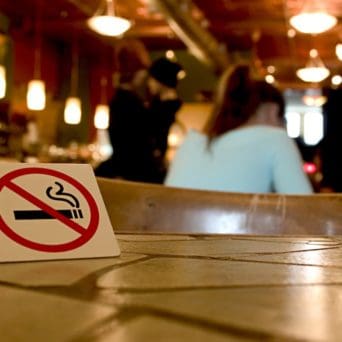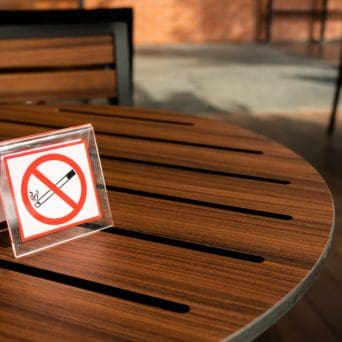By Liz Williams
April is National Healthy Homes Month, an ideal opportunity to promote how cities can support healthy housing policies that improve residents’ health and well-being. The Department of Housing and Urban Development defines healthy homes as “a century-old concept that promotes safe, decent, and sanitary housing as a means for preventing disease and injury.” Today, this encompasses a broad range of public health, habitability, and affordability issues that directly impact residents’ daily lives.
One of the National Center for Healthy Housing’s principles of a healthy home is being contaminant-free, which includes secondhand smoke. Decades of research have established that there is no safe level of exposure to secondhand smoke, and even low levels can be harmful to health due to the fine particulate matter that tobacco and marijuana smoking releases into the air. The Surgeon General’s Call to Action to Promote Healthy Homes states that “adopting smoke-free rules in homes reduces involuntary exposure to secondhand smoke and improves health.”
Indoor air quality affects residents in all housing types, but it can be particularly harmful in multi-unit housing, where air and contaminants can transfer between units. Multi-unit housing includes apartments, duplexes/triplexes, condominiums, townhomes, and semi-detached housing. Drifting secondhand smoke can enter common areas and other units through vents, doors, windows, hallways, electrical outlets, and gaps around fixtures and walls. This can create an asthma trigger and is a risk factor for respiratory illnesses, heart disease, and stroke.
Smoke-free laws can also help promote health equity. According to an analysis of census data by the National Association of Home Builders, about 31% of U.S. residences (43.9 million) are classified as multi-unit housing. Multi-unit residences are renters’ most common dwelling type, comprising 61% of the nation’s rental stock. Rental units are disproportionally rented by nonwhite households — about 58% of Black households and 52% of Hispanic- or Latino-led households rent their homes, compared to about 28% of non-Hispanic white households.
Tobacco industry marketing practices, a lack of smoke-free laws, and social determinants of health have resulted in some population groups — including young children, Black people, people with lower incomes, people with less education, and people who live in rental and multi-unit housing — to be more likely to be exposed to secondhand smoke. Smoke-free policies have the potential to help close these disparities by ensuring clean air for everyone in multi-unit housing, workplaces, and public spaces.

Smoke-free Momentum Grows: California Case Study
Cities across the nation are taking action by adopting local laws to expand smoke-free protections for residents. In California alone, more than 100 cities and counties have adopted local laws that regulate smoking in multi-unit housing. By expanding smoke-free protections to include multi-unit housing, California leaders recognized the importance of reducing the known health hazards of secondhand smoke exposure in a location where many people spend a significant amount of time — especially children, seniors, and people who work from home.
The best practice for smoke-free ordinances is for a jurisdiction to adopt a local law prohibiting smoking or vaping inside all multi-unit housing properties with three or more units. Policies should cover both rental and owner-occupied multi-unit residences, including condominiums, and the definition of smoking should include the smoking and vaping of both tobacco and marijuana.
The California Healthy Housing Coalition recently released its Principles for Equitable Smoke-Free Multifamily Housing to inform community conversations on this issue. The principles were collaboratively developed by partners in the tobacco control, public health, legal, and tenant rights fields to provide recommendations for communities looking to adopt smoke-free multi-unit housing laws. These principles aim to help ensure that smoke-free policies are equitable and supportive of all residents accessing a healthy, stable living environment, including people who smoke and their families. These principles include meaningful community engagement, culturally and linguistically appropriate resources and accommodations, and enforcement led by an entity such as the public health department that can provide education and support rather than legal or monetary penalties.
Of the nation’s 75 largest cities, Fresno is the first to adopt a local smoke-free multi-unit housing law, while several other large California cities are building community awareness and support for taking this policy step. The adoption of Fresno’s law in October 2021 was the result of years of hard work by the local tobacco control coalition, which engaged with residents and community partners to extend smokefree air protections to vulnerable residents living in multi-unit housing who were suffering negative health impacts from breathing secondhand smoke that drifted into their units.
Fresno’s law prohibits smoking and vaping tobacco and marijuana inside all multi-unit rental housing properties with two or more units. The city has an opportunity to strengthen its smoke-free ordinance by also including condominiums and other multi-unit owner-occupied properties, building on a strong first step to creating a healthier living environment for tenants in California’s fifth-largest city.
The Bottom Line
Everyone, regardless of housing circumstances, deserves to have a stable and healthy living environment, including the right to breathe smoke-free air at home. Residents of multi-unit housing shouldn’t have to suffer serious health risks from secondhand smoke drifting from neighbors’ units.
Cities can consider working with local tobacco control partners to raise awareness about the health risks of secondhand smoke exposure at home and prepare for adopting a local law extending smoke-free air protections to residents of multi-unit housing.
Resources are available to support cities interested in increasing the availability of smoke-free multi-unit housing. Learn more by checking out CityHealth’s policy criteria, CDC educational fact sheets, and information to educate landlords, tenants, and community partners. You can also check out CityHealth’s Smoke-Free Indoor Air policy and see how a city near you rates.
Liz Williams is project and policy manager at American Nonsmokers’ Rights Foundation





